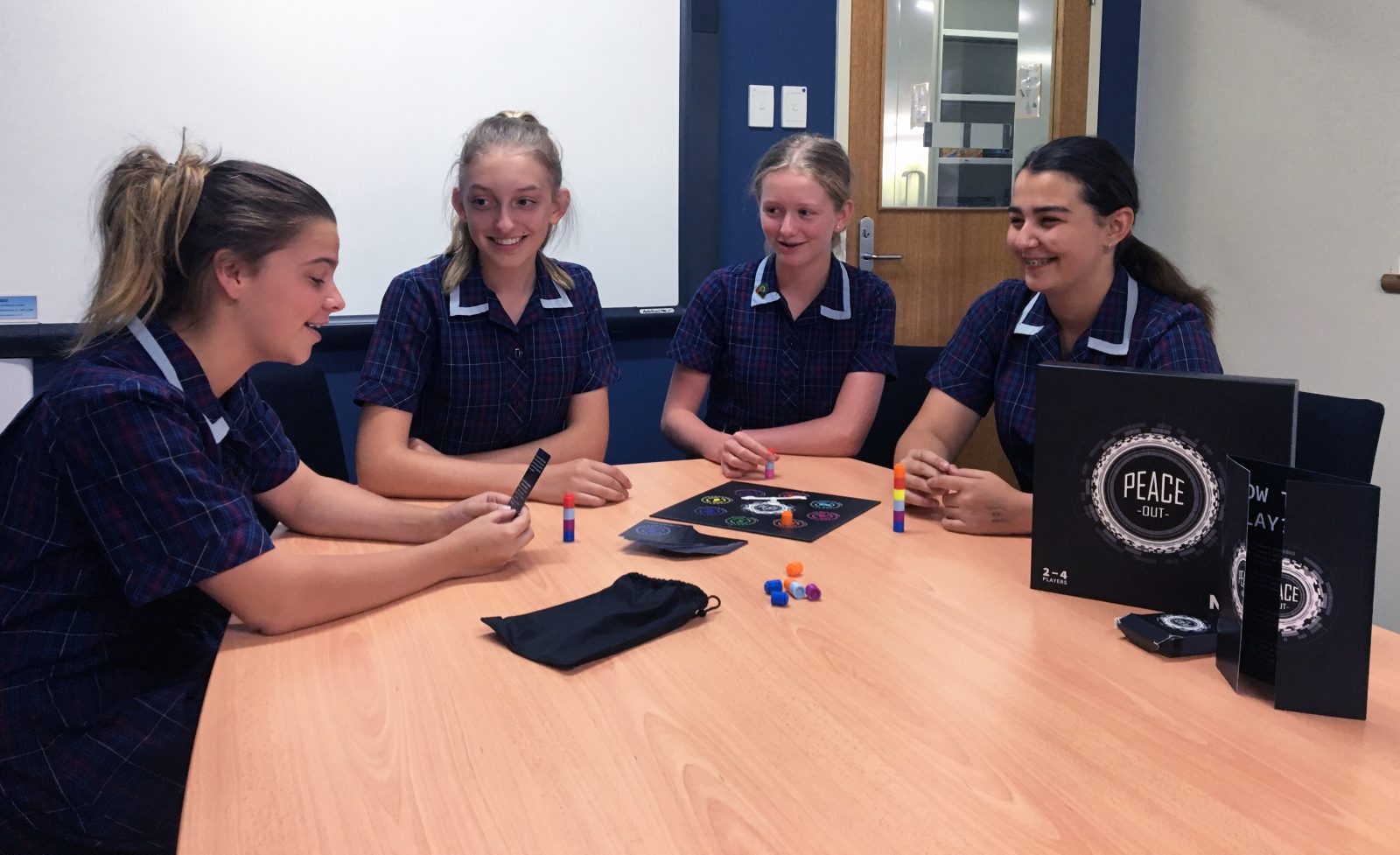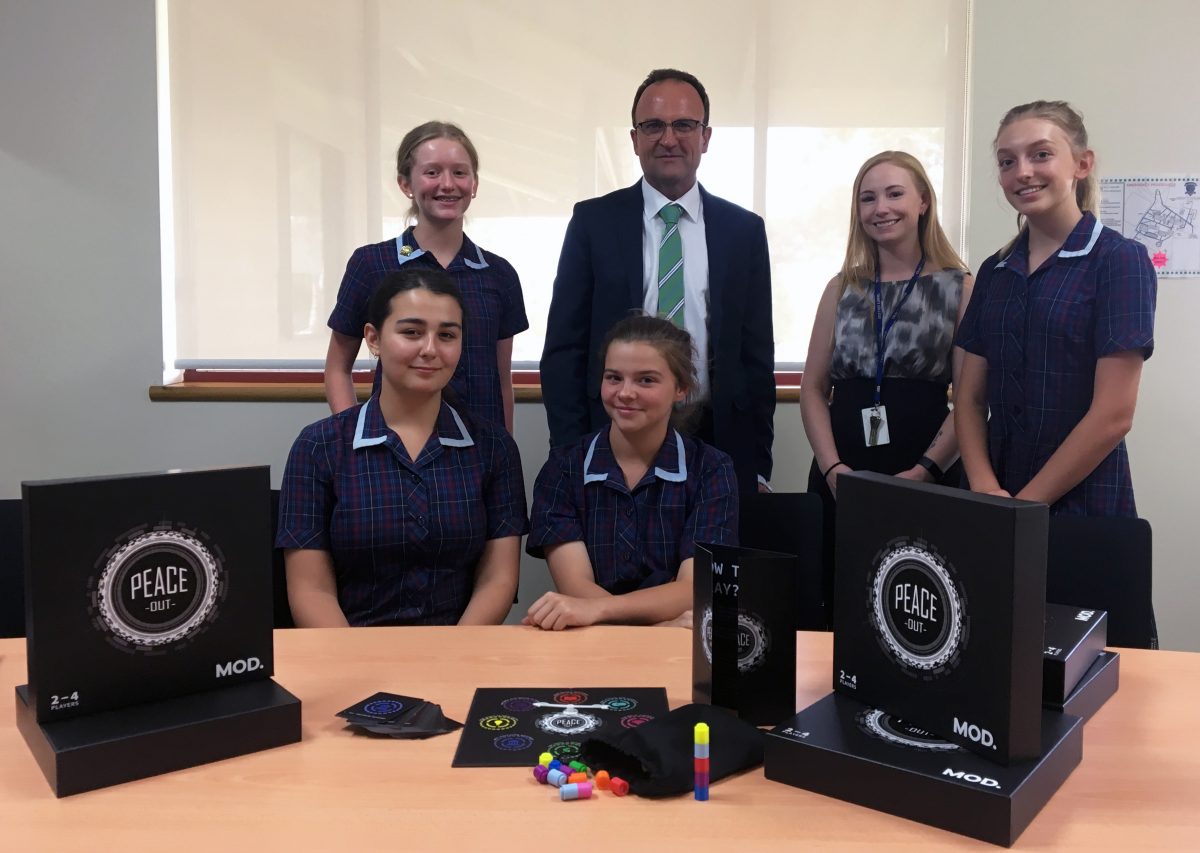Posted 12 Mar

When we opened our Peace Machine school project, we weren’t really sure what we were going to get. We were hoping for a mix of exciting and terrifying innovations from South Australian school students, and students across the state delivered.
We received some that would change the world, a necklace that split in half to help keep parents and children together as they cross borders, and an AI jury that takes the guess work out of sentencing. And then some that bring peace down to a more personal level, like a virtual reality mask to help with anxiety, or glasses that help you avoid people you won’t like. But a group of Trinity College South students came up with an excellent way to get young people invested in peace.
Peace Out is a board game targeted to teach young people about how they can incorporate peace into their daily lives. Built around the Institute of Economic and Peace’s Eight Pillars of Peace, players answer scenario cards and play to become the first to collect all eight pillars. We loved the way this game tied into international discussions about peace, but localising it to decisions we make every day. How do you decide where to eat when you want steak, but your friend is vegan? What do you do when your sibling eats the last piece of cake? Peace Out asks these questions.
Along with this group of Trinity students, we worked with Lucas Shaw, a recent design graduate from UniSA to visualise Peace Out. We then had the game manufactured, and now it is available for play in our board game café.
***

As a group we decided to create our Peace Machine around the concept of perspective, focusing on the eight Pillars of Peace that MOD. provided.
We wanted to create a machine where young people were put in situations requiring conflict resolution, aggressively pursuing peace by targeting young people. This was done by building the conflicts in the game around areas they deal with regularly. We believe that targeting a young audience to start building skills in peaceful conflict resolution meets the criteria of aggressively pursuing peace.
During the process we brainstormed many ideas including a kaleidoscope of perspectives, interactive apps, and board games. Through many lunch time meetings we decided the board game option was appropriate as it allows for interaction not just with the scenarios but with other young people at the same time. It also allows children to play the game at school or at home. We used some of our favourite games like Cluedo, Game of Life and Trivial Pursuit to help us garner ideas and create the basic layout and rules of our eventual development of Peace Out. We submitted photos to MOD. of the hardcopy game we created, sample scenario cards, and playing pieces.
We were fortunate enough to be offered the opportunity to attend a further brainstorming session at MOD. with Natalie and Lucas to continue the development of our board game.
– Keely Silvy, Max Grivell, Eden Smyth, Millie Moore, Phillip Crosby, Emilee Freer, Rebekah Penaluna, and Jordan Flay, Trinity College South
***
Peace Out was one of the most fun projects I’ve been able to work on. Not many people can say they got to make a board game. Working on Peace Out was a great way to kickstart my design career, and to start it for my high school, the place that started my interested in design. It was a real full circle moment and I enjoyed every moment of the collaborative and creative process.
Effectively the main concept of the game is about how to achieve peace. To me that feels very distance in the future, with this in mind the concept of the future and my interpretation of what that looks like became the back-bone and the influence for the visual aesthetic of the game. I think that the students came up with a brilliant game concept which I could see being mass produced and I was more than happy to bring their idea to life with MOD.’s help.
– Lucas Shaw, UniSA Design Graduate